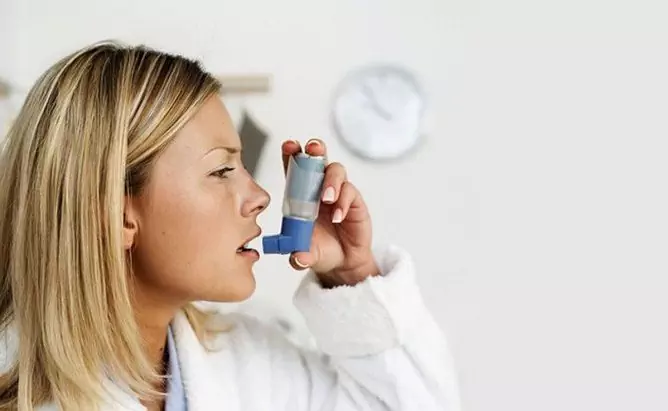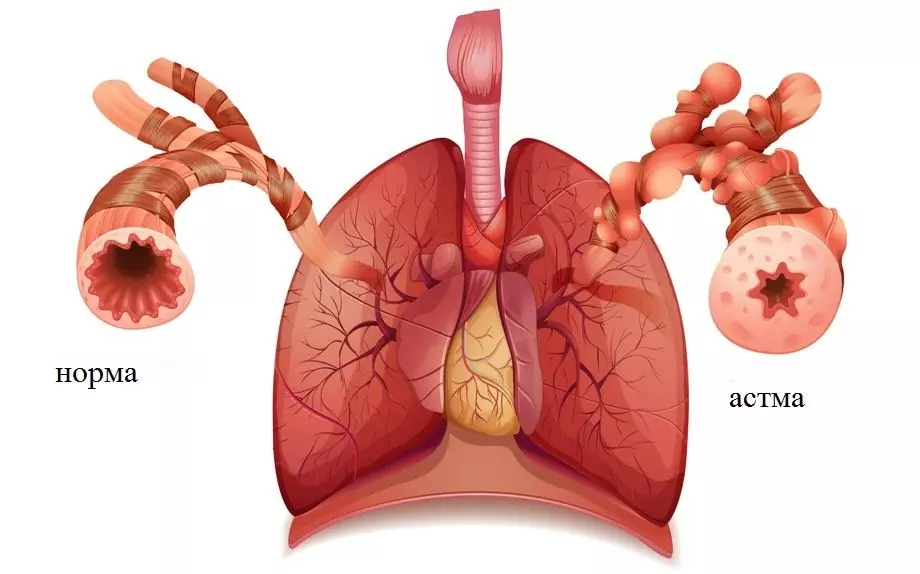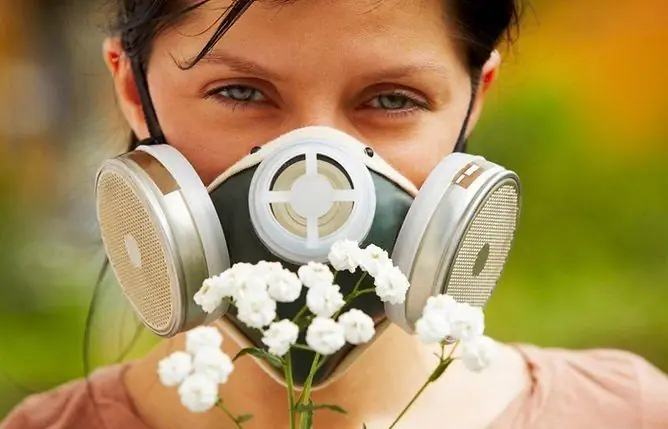- Author Rachel Wainwright [email protected].
- Public 2023-12-15 07:39.
- Last modified 2025-11-02 20:14.
Bronchial asthma: symptoms, causes, diagnosis and treatment
The content of the article:
- Bronchial asthma - what is it?
- Causes of bronchial asthma
- Classification
- Bronchial asthma symptoms
- Diagnostics
- Complications
- Treatment of bronchial asthma
- Prevention and prognosis
- Video
Bronchial asthma is a chronic non-infectious-inflammatory disease of the respiratory tract, which manifests itself in recurrent attacks of coughing, feelings of congestion in the chest, shortness of breath, wheezing in the lungs. With this disease, bronchial obstruction spontaneously or under the influence of therapy is completely or partially resolved.

Bronchial asthma is one of the most common chronic diseases
According to the WHO, there are currently over 235 million people in the world suffering from asthma. It is one of the most common chronic diseases and affects people of all ages and both sexes with equal frequency. In recent decades, there has been a steady increase in the incidence rate in children. Considering that asthma eventually leads to the formation of respiratory failure, a decrease in working capacity up to its complete loss is considered as one of the important medical and social problems.
Bronchial asthma - what is it?
Long-term inflammatory processes in the bronchi eventually lead to their hyperactivity, as a result of which contact with irritants or allergens causes rapidly developing bronchial obstruction. Clinically, this is manifested by a sudden attack of dry cough, noisy breathing, shortness of breath.
Asthma attacks occur in different patients with different frequencies. But even if the disease is in remission for a long time, the inflammatory process in the bronchopulmonary system remains active.
The pathological mechanism of the onset of bronchial obstruction includes the following components:
- spasm of smooth muscles of medium and small bronchi;
- swelling of the bronchial mucosa;
- the accumulation of thick and viscous sputum in the lumen of the bronchi, which is due to hyperfunction of the glands of the mucous membrane.
Long-term inflammation causes sclerotic changes in the bronchial walls, which is associated with the gradual replacement of the muscle tissue of the bronchial walls with connective tissue.
Asthma responds well to treatment. Modern drugs allow you to control the course of the disease, to achieve long-term, long-term remission.
Causes of bronchial asthma
Most often, the development of asthma is associated with contact with allergens, which can be:
- book and house dust;
- dandruff of animals;
- food for fish;
- some food products (citrus fruits, eggs, chocolate);
- medications;
- household chemicals;
- perfumery.
In 2% of patients, the disease is associated with work in hazardous production.
Infectious agents play an important role in the pathogenesis of asthma. This is due to the fact that microorganisms and the toxins they produce in some people can also cause sensitization of the body and provoke the development of allergic reactions. In addition, infectious agents maintain the activity of inflammation, which, in turn, increases bronchial hyperreactivity.
There are also a number of non-protein allergens (haptens). They enter the human body, interact with proteins and form complexes that trigger the onset of an allergic reaction.
In the etiology of the disease, factors such as hereditary predisposition, stress conditions, hypothermia, and smoking also play a role.
Allergens, once in the body of a sensitized person, begin to interact with a number of cells (mast cells, basophils). In this case, damage to their membranes occurs and biologically active substances called mediators of allergies (histamine, metabolites of arachidonic acid, leukotrienes) enter the bloodstream. These substances provoke a rapidly growing edema of the bronchial mucosa and hypersecretion of its glands.
Classification
Depending on the etiological factor, asthma is divided into the following types:
- allergic;
- non-allergic;
- mixed;
- unspecified.
According to the severity of the clinical course, asthma is:
- intermittent - attacks occur extremely rarely, no more than once a week;
- mild persistent - asthma attacks occur several times a week, but no more than once a day;
- persistent - attacks occur almost daily;
- severe persistent - suffocation occurs not only in the daytime, but also at night.
According to the activity of the process, the following stages of the disease are distinguished:
- aggravation;
- unstable remission;
- stable remission.
Depending on the level of disease control, controlled, partially controlled and uncontrolled asthma are distinguished.
When forming a diagnosis in an adult patient or child, all of the above characteristics must be indicated. For example, the diagnosis may be as follows: "Bronchial asthma of unspecified etiology, mild persistent, controlled, in the stage of unstable remission."
Bronchial asthma symptoms
During an attack of suffocation, several periods can be distinguished:
- The period of the harbingers. It is most pronounced in the infectious-allergic form of the disease. Its main symptom is vasomotor reactions (frequent sneezing, copious runny nasal discharge).
- The peak period. Sometimes it starts without a precursor stage. Patients report tightness in the chest, which makes breathing difficult. There is a cough with difficult expectoration, viscous sputum. Breathing becomes noisy. The inhalation is short, and the exhalation is difficult, long. Arrhythmia of respiratory movements may be noted. The patient assumes a forced position: sitting, with support on his hands and the body body slightly pushed forward. Swelling of the neck veins at the time of exhalation is noted. The face is puffy. In a severe attack, the auxiliary muscles are involved in the act of breathing.
- Reverse development period. It is characterized by thinning of sputum, a decrease in the number of wheezing in the lungs, and restoration of air exchange in the lungs.
Diagnostics
Diagnosis of asthma is carried out taking into account the data of the clinical picture of the disease, the results of a physical examination of the patient.

Asthmatic attacks are provoked by the accumulation of mucus in the lumen of the bronchi and their spasm
At the time of the attack, during auscultation in the lungs, vesicular weakened breathing with prolonged expiration and a large number of dry wheezing sounds are heard. With auscultation of the heart, attention is paid to muffled heart sounds, the appearance of a second accent above the pulmonary artery.
Chest percussion reveals:
- displacement of the border of the lungs downward;
- "Box" sound, the occurrence of which is associated with hyper-airiness of the lung tissue;
- reduction of the zone of absolute dullness of the heart.
To assess the degree of bronchial obstruction, spirometry and peak flowmetry are performed. If necessary, X-ray of the lungs, bronchoscopy, ECG, determination of blood gas composition are performed. In the allergic form of the disease, tests with various allergens are indicated.
Laboratory diagnosis of asthma includes the following methods:
- complete blood count (eosinophilia, increased ESR);
- general analysis of sputum (Kurshman spirals, Charcot-Leiden crystals, Creole bodies, a large number of eosinophils);
- study of the immune status (a sharp decrease in the activity and number of T-suppressors, increased levels of immunoglobulins in the blood);
- biochemical blood test (performed to exclude other pathologies with similar symptoms).
If an attack occurs for the first time, it is necessary to carry out a differential diagnosis between bronchial asthma and allergic bronchitis. It is possible to assume that a patient has asthma in the presence of the following manifestations of the disease:
- wheezing high-pitched wheezing that occurs on exhalation;
- repetition of episodes of shortness of breath, cough, compression in the chest;
- a history of allergic diseases (atopic dermatitis, spring hay fever, eczema);
- pronounced seasonality of deterioration in well-being;
- the occurrence of an attack of suffocation at the time of contact with allergens (less often under the influence of physical exertion, emotional stress, hypothermia and other factors);
- chronic or frequently recurring acute diseases of the respiratory system;
- improvement of the patient's condition after the use of anti-asthma and antihistamines.
Complications
With a severe course and intense attacks of asthma, asthma can be complicated by the development of acute pulmonary emphysema, secondary cardiopulmonary insufficiency.
A rapid decrease in the dose of corticosteroid hormones or an overdose of beta-adrenostimulants, as well as contact with a large number of allergens, can lead to a life-threatening condition - status asthmaticus. It is characterized by almost continuous succession of attacks of suffocation, which cannot be stopped by conventional methods.
Treatment of bronchial asthma
The mainstay of asthma treatment, regardless of the frequency and intensity of attacks, is:
- compliance with the elimination diet;
- cessation of contact with possible allergens;
- rational employment.
To reduce the severity of sensitization of the body, a specific (if the allergen is known) or non-specific (if the allergen is not identified) hyposensitizing therapy is carried out.
For the relief of asthma attacks, patients are usually prescribed beta-agonists in aerosol form. Aerosols of m-anticholinergics are also quite effective.
In order to prevent asthma attacks, xanthine derivatives are used in the form of tablets with a prolonged effect of action.
In recent years, calcium antagonists and drugs that prevent mast cell degranulation have been used to treat asthma.
The complex therapy of severe forms of the disease includes corticosteroid hormones in tablet or injectable form.
In order to improve the discharge of sputum, mucolytic and expectorant drugs may be prescribed.
Be sure to actively treat other diseases of the respiratory system (bronchopneumonia, chronic bronchitis).

There is an increase in the incidence of asthma in children
As the patient's condition improves, the doctor gradually reduces the dosage of drugs.
Prevention and prognosis
During asthma, as in the course of any chronic disease, periods of remission and exacerbations are observed. Modern methods of therapy make it possible to achieve long-term and stable remission.
The prognosis largely depends on how carefully the patient complies with the doctor's prescriptions, fulfills all his recommendations.
Disease prevention includes the following activities:
- to give up smoking;
- active sanitation of foci of chronic infection in the body;
- minimization of contact with allergens;
- improving working conditions;
- careful observance of safety rules when working in hazardous production.
It is especially important to carry out the prevention of the development of the disease among persons with a burdened heredity or those at risk for the development of this disease.
Video
We offer for viewing a video on the topic of the article.

Elena Minkina Doctor anesthesiologist-resuscitator About the author
Education: graduated from the Tashkent State Medical Institute, specializing in general medicine in 1991. Repeatedly passed refresher courses.
Work experience: anesthesiologist-resuscitator of the city maternity complex, resuscitator of the hemodialysis department.
The information is generalized and provided for informational purposes only. At the first sign of illness, see your doctor. Self-medication is hazardous to health!






